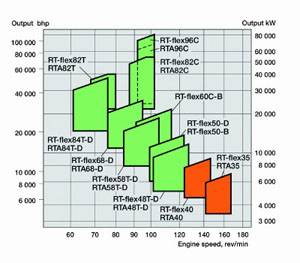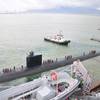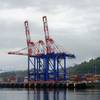MHI and Wärtsilä to Jointly Develop Small-Size Engines
Mitsubishi Heavy Industries, Ltd. (MHI) and Wärtsilä Corporation of will jointly develop new small, low-speed marine diesel engines with cylinder bores of 350 and 400 millimeters (mm). The two companies agreed on joint design and development of engines of less than 450 mm cylinder bore in May 2008, based on a previously signed strategic alliance agreement.
The new engines, to have a power range of 3,500–9,000 kW, will be developed in collaboration, taking advantage of the strengths of the two companies. For both the 350 mm and 400 mm cylinder bore models, MHI will develop the mechanically controlled UEC-LSE series, and Wärtsilä will develop the Wärtsilä RT-flex electronically controlled common-rail engines and Wärtsilä RTA mechanically controlled engines. The first of the 350 mm bore engines will be available in the first quarter of 2011 and the 400 mm bore engines a year later.
The new engines will extend the low-speed engine range available for many types of small and medium-sized commercial vessels. They are being designed to provide the optimal power and speed for a wide variety of ship types, such as small handysize bulk carriers of less than 30,000 deadweight t onnage (DWT), product tankers, general cargo vessels, reefers, feeder container ships, and small LPG carriers. The market for the new engines in such vessels is world-wide, though there is a greater volume of such new constructions at shipyards in East Asia, especially , , and .
The key benefits of the new engines will be compliance with IMO Tier II emissions regulations, low fuel consumption, a low cylinder oil feed rate, high reliability, and long times between overhauls. They will also be able to provide optimum fits to ships in terms of power, propeller speed, dimensions, weight, and electrical power consumption, as well as being competitive in manufacturing costs.
The Mitsubishi UEC35LSE, Wärtsilä RT-flex35 and Wärtsilä RTA35 engine types will have cylinder dimensions of 350 mm bore by 1,550 mm piston stroke, and a maximum continuous power of 870 kW/cylinder at 167 rev/min (see table below). The Mitsubishi UEC40LSE, Wärtsilä RT-flex40 and Wärtsilä RTA40 will have cylinder dimensions of 400 mm bore by 1,770 mm piston stroke, and a maximum continuous power of 1,135 kW/cylinder at 146 rev/min. All these engine types will be available with five to eight cylinders, so that the UEC35LSE, RT-flex35 and RTA35 will cover an overall power range of 3,475 to 6,960 kW at 142–167 rpm, while the UEC40LSE, RT-flex40, and RTA40 will cover an overall power range of 4,550 to 9,080 kW at 124–146 rpm.
The Wärtsilä RT-flex35 and RT-flex4 0 engines will incorporate the latest common-rail technology with full electronic control of fuel injection and exhaust valve operation. The RTA35, UEC35LSE, RTA40 and UEC40LSE will have traditional mechanically driven camshafts with fuel injection pumps, exhaust valve actuator pumps, etc. Otherwise both versions will have the same principal characteristics and design features.
The Wärtsilä RT-flex and RTA engines will be manufactured by Wärtsilä’s licensees while the Mitsubishi UEC-LSE engines will be produced by Mitsubishi and its licensees.













